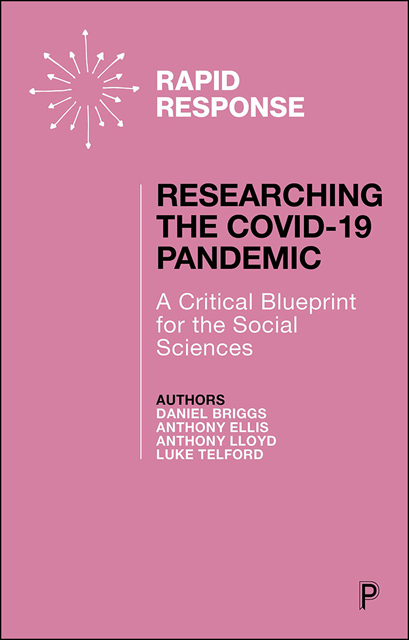Book contents
- Frontmatter
- Dedication
- Contents
- List of figures and tables
- Acknowledgements
- Foreword
- 1 Apocalypse then: The world pre-COVID-19 and the state of the social sciences
- 2 Viral Armageddon: The spread and impact of COVID-19
- 3 Apocalypse now: The (desk-based) scramble for knowledge
- 4 Studying the COVID-19 pandemic as it happens
- 5 Apocalyptic futures: An appeal to the social sciences
- Notes
- References
2 - Viral Armageddon: The spread and impact of COVID-19
Published online by Cambridge University Press: 15 April 2023
- Frontmatter
- Dedication
- Contents
- List of figures and tables
- Acknowledgements
- Foreword
- 1 Apocalypse then: The world pre-COVID-19 and the state of the social sciences
- 2 Viral Armageddon: The spread and impact of COVID-19
- 3 Apocalypse now: The (desk-based) scramble for knowledge
- 4 Studying the COVID-19 pandemic as it happens
- 5 Apocalyptic futures: An appeal to the social sciences
- Notes
- References
Summary
Viral pandemics are nothing new and throughout history have generated significant social distress and suffering. Perhaps the most devastating pandemic in recent history was the 1918 Spanish influenza, since it possessed a fatality rate of around 10% and killed over 40 million people worldwide. Thereafter, the 1968 Hong Kong flu also generated considerable social chaos across the globe, being associated with over one million fatalities. The 2009 swine flu pandemic lasted for nearly two years, and by comparison generated far fewer deaths than the Spanish influenza and Hong Kong flu, killing around 280,000 people. Yet since then, scientists have persistently warned about the potential for another global pandemic, in particular virologists, who claimed that climate change, global urbanisation and the interconnected nature of a globalised world could produce the right elements for rapid human-tohuman transmission should a virus emerge (Žižek, 2020). Such warnings, however, largely fell on deaf ears among the global political elite. Combined with neoliberalism's structural conditions outlined in the previous chapter, many nations were left radically underprepared for the outbreak of COVID-19 in December 2019.
Importantly, in the early period of 2020, the virus was spreading quickly, and generally the elderly or already vulnerable were dying at a fast rate. This set governments and the media into a frenzy as there was no known cure or remedy and no vaccine (Blakeley, 2020). Little was known about how the virus was transmitted and while large numbers of extremely sick patients were admitted to hospitals, some recovered quickly while others were unaffected by it. While some nation states locked down quickly, others such as the US played down the severity of the virus (Žižek, 2021). As we write, over three million people worldwide are known to have died from or with the virus. Therefore, it is important to weigh this against some of the arguments we provide in the book. We are not ‘COVID deniers’ – people who are sceptical about the existence of the virus. We know it exists. We know it is a threat to some people. We know it has caused immeasurable suffering among millions of families.
- Type
- Chapter
- Information
- Researching the COVID-19 PandemicA Critical Blueprint for the Social Sciences, pp. 17 - 36Publisher: Bristol University PressFirst published in: 2023



